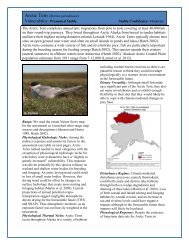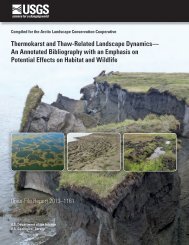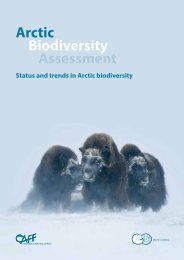Assessing Climate Change Vulnerability of Breeding Birds in Arctic ...
Assessing Climate Change Vulnerability of Breeding Birds in Arctic ...
Assessing Climate Change Vulnerability of Breeding Birds in Arctic ...
You also want an ePaper? Increase the reach of your titles
YUMPU automatically turns print PDFs into web optimized ePapers that Google loves.
Cackl<strong>in</strong>g/Canada Goose (Branta hutch<strong>in</strong>sii / canadensis)<strong>Vulnerability</strong>: Presumed StableConfidence: HighCackl<strong>in</strong>g and Canada Geese were recently split <strong>in</strong>to two species. The Cackl<strong>in</strong>g Goose tavernerisubspecies is thought to be the dom<strong>in</strong>ant breeder on Alaska’s <strong>Arctic</strong> Coastal Pla<strong>in</strong> although someevidence suggests they may <strong>in</strong>terbreed with Canada Goose parvipes subspecies (Mowbray et al.2002). Coastal pla<strong>in</strong> Cackl<strong>in</strong>g/Canada geese nest <strong>in</strong> moist sedge shrub tundra with brood rear<strong>in</strong>g<strong>in</strong> wet sedge meadows, <strong>of</strong>ten near the coast (Mowbray et al. 2002). On the coastal pla<strong>in</strong> their dietis dom<strong>in</strong>ated by Carex spp. (J. Hupp, pers. comm.). <strong>Arctic</strong> Alaskan populations w<strong>in</strong>ter primarily<strong>in</strong> w. Wash<strong>in</strong>gton and Oregon as well as n. California (Mowbray et al. 2002). The Alaskan<strong>Arctic</strong> Coastal Pla<strong>in</strong> population is estimated at ~8,000 with a stable population (Larned et al.2012).S. Zack @ WCSRange: We used the extant NatureServe map forthe assessment as it matched the <strong>Birds</strong> <strong>of</strong> NorthAmerica range description (Mowbray et al.2002). It should be noted that most birds occurnear Teshekpuk Lake (J. Hupp, pers. comm.).Physiological Hydro Niche: Reliance onparticular hydrologic conditions was ranked asthe greatest potential source <strong>of</strong> vulnerability forthe Cackl<strong>in</strong>g/Canada geese. This response wasdriven primarily by this species close associationwith moist/wet sedge communities and largelakes for both nest<strong>in</strong>g and forag<strong>in</strong>g. A dry<strong>in</strong>gtrend could have negative impacts by reduc<strong>in</strong>gavailability <strong>of</strong> suitable habitats. Currentprojections <strong>of</strong> annual potential evapotranspirationsuggest negligible atmosphericdrivendry<strong>in</strong>g for the foreseeable future (TWSand SNAP). Thus atmospheric moisture, as anexposure factor (most <strong>in</strong>fluential on the“hydrological niche” sensitivity category), wasnot heavily weighted <strong>in</strong> the assessment.Human Response to CC: All-weather roads(necessitated by a warm<strong>in</strong>g climate andshortened ice road season) associated withenergy extraction activities could impactbreed<strong>in</strong>g and molt<strong>in</strong>g habitats, particularly nearTeshekpuk Lake. However, comb<strong>in</strong>ed sources <strong>of</strong>human activity related to climate changemitigation will likely be m<strong>in</strong>imal and localized<strong>in</strong> the near future.Physiological Thermal Niche: Because thisspecies is distributed across a broad thermalrange <strong>in</strong> North America they are likely notimpacted or could benefit from warm<strong>in</strong>gtemperatures, reduc<strong>in</strong>g stress related to earlyseason cold temperatures.Disturbance Regime: <strong>Climate</strong>-mediateddisturbance processes, namely thermokarst,could both create and destroy forag<strong>in</strong>g andnest<strong>in</strong>g habitats through both ice wedgedegradation and dra<strong>in</strong><strong>in</strong>g <strong>of</strong> thaw lakes (Mart<strong>in</strong>et al. 2009). Likewise, predicted <strong>in</strong>creasedcoastal erosion and result<strong>in</strong>g sal<strong>in</strong>ization (Joneset al. 2009) could both negatively and positivelyaffect nest<strong>in</strong>g and stag<strong>in</strong>g birds by destroy<strong>in</strong>gand creat<strong>in</strong>g nest<strong>in</strong>g, forag<strong>in</strong>g, and molt<strong>in</strong>ghabitats.Dietary Versatility: Because this speciescomplex relies so heavily on Carex spp. as a dietsource, any reduction <strong>in</strong> this food source relatedto climate could have negative consequences.Genetic Variation: Current mitochondrial DNAevidence suggests Cackl<strong>in</strong>g/Canada geese have48








